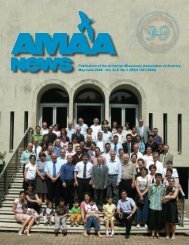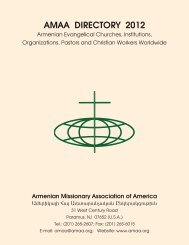Annual Report 2009 - Armenian Missionary Association of America
Annual Report 2009 - Armenian Missionary Association of America
Annual Report 2009 - Armenian Missionary Association of America
Create successful ePaper yourself
Turn your PDF publications into a flip-book with our unique Google optimized e-Paper software.
Note 5 – Fair Value Disclosures<br />
Fair Value Measurements<br />
As defined in the “Fair Value Measurements” standard, fair value is the price that would be received to sell an asset or paid to transfer a<br />
liability in an orderly transaction between market participants at the measurement date. In determining fair value, the AMAA uses various<br />
methods including market, income and cost approaches. Based on these approaches, the AMAA <strong>of</strong>ten utilizes certain assumptions that<br />
market participants would use in pricing the asset or liability, including assumptions about risk and or the risks inherent in the inputs to the<br />
valuation technique. These inputs can be readily observable, market corroborated, or generally unobservable inputs. The AMAA utilizes<br />
valuation techniques that maximize the use <strong>of</strong> observable inputs and minimize the use <strong>of</strong> unobservable inputs. Based on the observability<br />
<strong>of</strong> the inputs used in the valuation techniques, the AMAA is required to provide the following information according to the fair value<br />
hierarchy. The fair value hierarchy ranks the quality and reliability <strong>of</strong> the information used to determine fair values. Financial assets and<br />
liabilities carried at fair value will be classified and disclosed in one <strong>of</strong> the following three categories:<br />
• Level 1 — Valuations based on quoted prices in active markets for identical assets or liabilities that the reporting entity has the<br />
ability to access at the measurement date. An active market for the asset or liability is a market in which transactions for the<br />
asset or liability occur with sufficient frequency and volume to provide pricing information on an ongoing basis.<br />
• Level 2 — Valuations based on inputs other that level 1 that are observable for the asset or liability, either directly or indirectly.<br />
Level 2 inputs include quoted prices for similar assets or liabilities in active markets or quoted prices for identical or similar assets<br />
and liabilities in markets that are not active. If assets or liabilities have a specified contractual term, the inputs must be observable<br />
for substantially the full term <strong>of</strong> the asset or liability.<br />
• Level 3 — Valuations for assets and liabilities derived from unobservable inputs. Unobservable inputs are used to the extent<br />
that observable inputs for level 2 are not available. Unobservable inputs reflect the reporting entities own assumptions about the<br />
assumptions that market participants would use in pricing such assets or liabilities.<br />
For the fiscal year ended July 31, 2010 and <strong>2009</strong>, the application <strong>of</strong> valuation techniques applied to similar assets and liabilities has been<br />
consistent. The following is a description <strong>of</strong> the valuation methodologies used for instruments measured at fair value:<br />
Corporate Stocks<br />
The fair value <strong>of</strong> corporate stocks is the market value based on quoted market prices, when available, or market prices provided by<br />
recognized broker dealers. If listed prices or quotes are not available, fair value is based upon externally developed models that use<br />
unobservable inputs due to the limited market activity <strong>of</strong> the instrument.<br />
Bonds, Notes, and Structured Settlements<br />
Bonds and notes consist <strong>of</strong> corporate and government bonds where fair value is the market value based on quoted market prices, when<br />
available, or market prices provided by recognized broker dealers. If listed prices or quotes are not available, fair value is based upon<br />
externally developed models that use unobservable inputs due to the limited market activity <strong>of</strong> the instrument.<br />
Structured Settlement Contracts do not trade in an active, open market with readily observable prices. While sales <strong>of</strong> structured settlements<br />
do occur, the precise terms and conditions typically are not readily available. Accordingly, the AMAA estimates the fair value <strong>of</strong><br />
these contracts using discounted cash flow (“DCF”) models incorporating numerous assumptions from the perspective <strong>of</strong> market participant<br />
including servicing income, servicing costs, market discount rates, prepayment speeds, and default rates. Due to the nature <strong>of</strong> the<br />
valuation inputs, these contracts are classified within Level 2 <strong>of</strong> the valuation hierarchy.<br />
Real Estate<br />
Real estate investments are carried at fair value and are generally classified within Level 2 <strong>of</strong> the valuation hierarchy. Values are based on<br />
certified appraisal reports and available comparable sales market data. However, certain real estate holdings, including various holdings<br />
in Lebanon, are classified within Level 3 because valuation is not practical due to geographic volatility. These investments are carried at<br />
acquisition value since this approximates fair value, based on recent sales.<br />
Loans Receivable<br />
Loans receivable are not traded in an active, open market and are instead measured at fair value on a nonrecurring basis; that is, the<br />
loans receivable are not measured at fair value on an ongoing basis but are tested for impairment annually. Loan performance and credit<br />
risk are considered when evaluating loans for improvement.<br />
Fair Value on a Recurring Basis<br />
The table below presents the balances <strong>of</strong> assets and liabilities measured at fair value on a recurring basis at July 31, 2010:<br />
Total Level 1 Level 2 Level 3<br />
Corporate Stocks $ 59,194,023 $ 59,194,023 $ - - $ - -<br />
Bonds and Notes 4,331,501 4,331,501 - - - -<br />
Mutual Funds 6,173,921 - - 6,173,921 - -<br />
Structured Settlements 1,205,360 - - 1,205,360 - -<br />
Real Estate Investments 23,232,757 - - 19,256,777 3,975,980<br />
Total Investment Assets $ 94,137,562 $ 63,525,524 $ 26,636,058 $ 3,975,980<br />
24
















